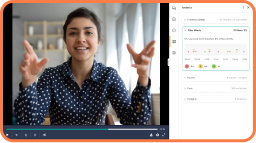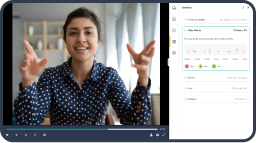“One of the biggest misconceptions that beginning online instructors have is that ‘if I can teach in the classroom, I can teach online.’ Teaching in the classroom and online require two totally different approaches to activity and task design for accomplishing your learning objectives for the particular class.” —Dr. Muthu Ramachandran, Leeds Beckett University
Adapting your face-to-face courses to a hybrid or online environment? You’re not alone.
The good news is that you don’t have to overhaul your course content to make it a success. Dr. Ramachandran argues that the key to successful hybrid and online courses is how you approach, build, and present tasks and activities.
To keep engagement high during your switch to hybrid or online teaching, here are five strategies to facilitate interactive learning during course activities and assignments.
Free Download: 5 Strategies for Interactive Learning in Hybrid and Online Courses
1. Schedule Your Content
To successfully transition online, begin by scheduling your content for the semester. Schedule content to release at specific times, rather than releasing it all at once. If you schedule your content, students won’t be able to see every course assignment and activity at the beginning of the semester. Instead, they’ll see upcoming assignments on their LMS dashboard each week.
Why is this practice particularly effective for hybrid and online teaching? Lasse Rouhiainen, best-selling author and international expert on disruptive technologies, explains that by scheduling the release of activities and assignments, you can facilitate interactive learning. That’s because if you have all of your course content published at the beginning of the semester, your students may either feel overwhelmed or jump ahead to complete the course as fast as possible. And it’s hard to have productive class discussions when students complete coursework at different times, so scheduling your content keeps your students on the same page.
2. Facilitate Collaboration
After figuring out when you’ll schedule your content, make sure to include several collaborative activities and assignments throughout the semester. A study conducted by Gbolahan Olasina shows that collaborative behavior and activities are a best practice for e-learning. To support collaboration in your hybrid or online course, create groups for discussions and assignments. Online or hybrid learning may feel isolating for students, so it’s a good idea to switch up groups throughout the semester. This will provide opportunities for students to gain fresh insights and work with new classmates.
Just like your face-to-face courses, you need to make sure these discussions are productive and engaging. How? The same way you did it before—listen in on group conversations.
When using a synchronous video tool to observe group discussions, you’ve only got so much time to make your rounds. Consider using an asynchronous video tool like GoReact to observe and leave feedback on group discussions and assignments. With GoReact, students can record and upload their conversations so instructors can review and give feedback anytime and anywhere.
3. Include Interactive Media
Along with emphasizing collaboration, hold your students’ attention by including interactive media in your lectures. According to University of Kansas professor Michael Ralph, providing video, audio, reading, and interactive content can make an online course more engaging.
While lecturing, you may post a YouTube link in the chat and ask the class to watch it immediately. Afterward, discuss the video and pose relevant questions. Because students often get sidetracked during online lectures, this is an excellent practice to capture students’ attention and pull them away from distractions.
Along with lectures, it’s important to include media in activities and assignments as well. You may assign your students to watch a short video and submit a written response or record a video response about their insights. You could also pair up your students and have them interpret the meaning of a specific image or video.
4. Incorporate Asynchronous Assignments
In order to create an engaging online experience, incorporate asynchronous assignments and activities. Research by Mei-jung Wang shows that engaging hybrid and online experiences require a blend of synchronous and asynchronous tools. That’s because adding asynchronous elements to your course provides flexibility, convenience, and accessibility. Here are a few ideas to add asynchronous assignments and activities to your course.
Forums: According to Sean Michael Morris, director of digital learning at the University of Mary Washington, “By asking open-ended questions, by giving students the opportunity for dialogue in an unassessed or ungraded space, the discussion forum can become a site within online learning for ‘college’ to happen.”
Use forums to ask open-ended questions, share news stories, or post relevant Ted Talks or YouTube videos. Encourage your students to reflect and share their thoughts on the forum. You could also assign your students to create their own discussion prompts. Whichever way you use forums in your course, make sure to give clear instructions in order to help your students understand what you expect their responses to look like.
Response Essays and Videos: You may find that it’s more difficult to gauge student understanding online than in a traditional face-to-face course. Response essays are a great tool to gather student insights and assess comprehension. Written responses are a staple in online courses, but there’s a secret to really engaging your students—video. Response videos add a personal element, providing a framework to build community in a hybrid or online environment. And students may think more carefully about their message when required to film themselves.
Social Media: Social media can be a great way to interact and connect with your students. You can create a class Facebook page or group to give class updates and foster discussion. Twitter is another effective platform for conversation by creating a class hashtag or starting a thread for your students to tweet relevant information. You could also create a class Instagram page for your students to share their insights in the comments section of specific posts, which would provide an easy way for students to see classmates’ responses. If you’re stuck on how to effectively use social media, ask the social media experts—your students—for feedback and ideas.
5. Provide Examples
Make sure to provide plenty of examples after giving your students an assignment in your hybrid or online course. Because misunderstandings and miscommunications happen more frequently over a computer screen than in-person, providing examples will help your students better understand what you expect from them.
Not everybody processes information the same way, so it’s important to include multiple examples for your students. As a guide from The Chronicle of Higher Education puts it, “Online learners benefit from multiple explanations of difficult concepts and multiple examples of the kind of work you want to see.” Here are a few ideas you may implement to provide a variety of examples in your hybrid or online course:
- Browse YouTube to find existing videos that explain concepts or principles in a different way.
- Pair students together and assign them to explain to each other how they understood a particular concept.
- Include student examples from previous semesters.
- Create a FAQ page for lessons that include difficult content to understand.
By implementing these five strategies, you’ll be able to facilitate active learning during class activities and assignments in hybrid and online courses.
You may also enjoy our article “Embracing Asynchronous Video: The Limitations of Zoom for Online Learning“






